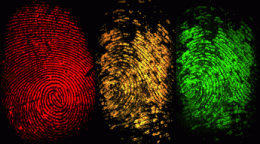Fingerprints tell all: Progress in fingerprint analysis

(PhysOrg.com) -- It has long been well established that fingerprints can be used to identify people or help convict them of crimes. Things have gone a lot further now: fingerprints can be used to show that a suspect is a smoker, takes drugs, or has handled explosives, among other things. In the journal Angewandte Chemie, Pompi Hazarika and David Russell describe the noteworthy progress that has recently been made.
When a finger touches a surface, sweat and oil-containing substances like sebum leave behind a print that is invisible to the naked eye. There are several ways to make it visible, like dusting with powder or spraying with reagents or “superglue”. A new technique that improves sensitivity involves the deposition of gold nanoparticles attached to cage-like molecules filled with dyes or other luminescent makers that cause the fingerprint pattern to glow. Gold nanoparticles attached to antibodies against amino acids are better at revealing older, dried fingerprints.
If a person has taken drugs, traces are released in his or her sweat. A team working with Russell at the University of East Anglia (Norwich, UK) has recently developed a method by which magnetic particles are equipped with antibodies that bind specifically to certain drug or nicotine metabolites. In a second step, they apply a fluorescent antibody, which binds to the first antibody and indicates the presence of the corresponding drug by glowing under a fluorescence microscope. By using this method, the researchers were able to simultaneously detect several different narcotics in a single fingerprint.
Other innovative approaches use chromatographic and mass spectrometric techniques to identify the components of sweat and their decomposition products in fingerprints. One exciting development is the use of desorption electrospray ionization mass spectrometry (DESI). Charged droplets of solvent are sprayed onto the surface, forming a film that dissolves materials out of the fingerprint. Additional solvent droplets impact the film and release the dissolved analytes from the surface so that they can be analyzed by mass spectrometry. An image of the fingerprint is then computed. Traces of drugs and explosives can also be shown.
Another interesting technique is infrared spectroscopy, which has been used to separate overlapping fingerprints from two individuals by means of their different sebum contents to produce two separate images. It is also possible to detect traces of explosive. Raman spectroscopy can be used to identify pharmaceuticals like aspirin and paracetamol (acetaminophen), as well as caffeine and starch in fingerprints.
The goal is to develop a cost-effective, rapid, portable, miniature system that can detect fingerprints and the chemical components in them. This would not only be useful for criminologists, but also for doping tests and diagnostics.
More information: David Russell, Advances in Fingerprint Analysis, Angewandte Chemie International Edition, dx.doi.org/10.1002/anie.201104313
Journal information: Angewandte Chemie International Edition
Provided by Wiley

















